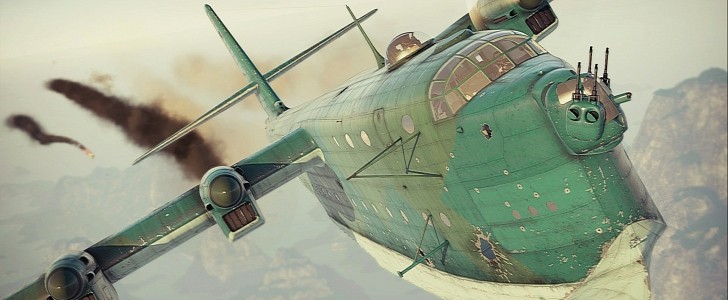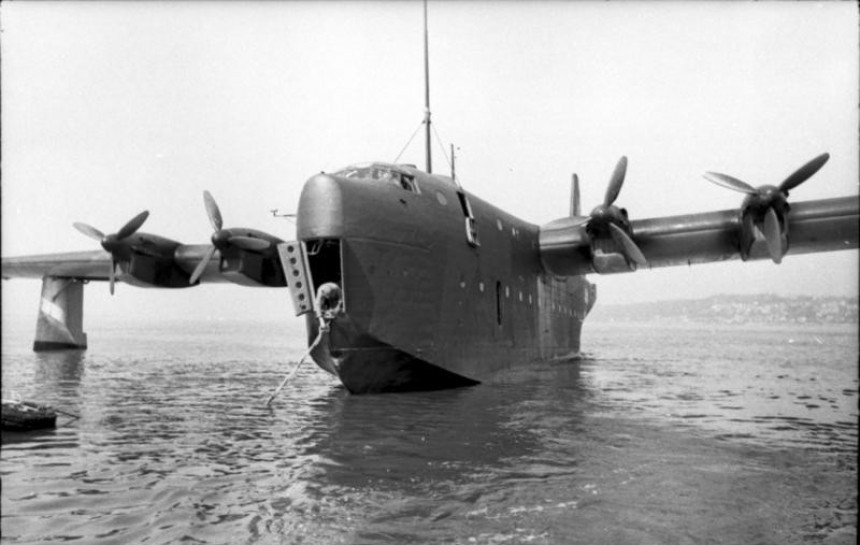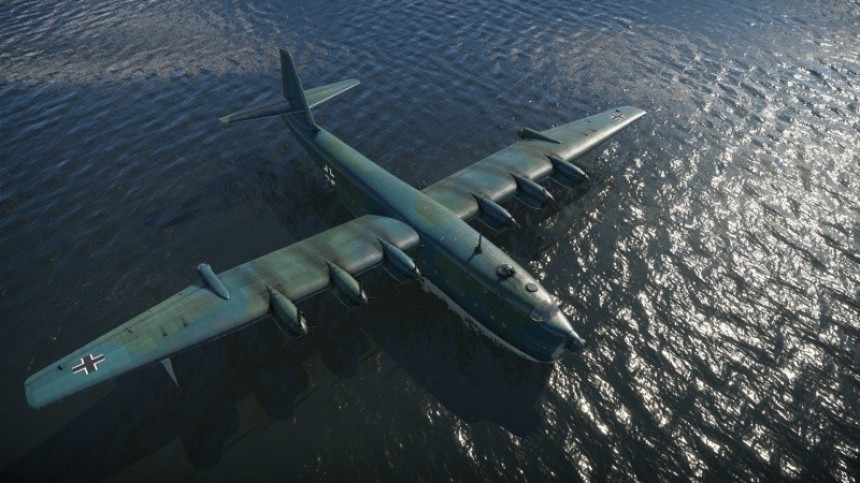The Blohm & Voss BV 238 owes its considerable online notoriety these days to a silly little free-to-play game by Gaijin Entertainment called War Thunder. As the largest and heaviest airplane ever to fly during World War II, its addition to the game has been a catalyst for some top-tier memes.
But for those among you who don't spend a portion of their waking free time grinding War Thunder's tech trees, let's take a deep dive into the story of Germany's largest military flying boat. It's a tale of desperation, ingenuity, and the prevailing idea that the war was not going to end well for the Third Reich.
Abteilung Flugzeugbau der Schiffswerft Blohm & Voss, or Hamburger Flugzeugbau for short, was the aeronautical division of the historic Blohm & Voss shipbuilding company of Hamburg, Germany. Similar to the British Saunders-Roe Company, Blohm & Voss specialized largely in the area of flying boats. These are defined as seaplanes with ship-like hulls as opposed to floatplanes using water skids instead of a landing gear.
Founded in 1933, the company consolidated its name to Blohm & Voss in 1937 to avoid confusion. Their two most notable production models were the BV 138 tri-motor, a twin-boom flying boat, and a military cargo flying boat that was smaller than the BV 238 but still nonetheless massive, called the BV 222 Wiking. Despite finding their home on the water, Blohm & Voss flying boats were under the jurisdiction of the land-based German Air Force (Luftwaffe) as opposed to the German Navy (Kriegsmarine).
The first whisperings of an attempt to build the largest flying boat ever constructed at that time date back to early 1941, during the dog days of Operation Barbarossa. The concept was simple in theory but endlessly complex in practice. What was required was a super heavy cargo transport airplane capable of hauling hundreds of troops, dozens of vehicles, or whatever cargo the German Wehrmacht required over vast distances. Potentially even trans-Atlantic.
A roughly quarter-scale model of the BV 238 was constructed in German-occupied Czechoslovakia. First flying in September 1944. Though not exactly identical to the 238 in terms of looks, the design allowed German engineers to study the novel, durable, and highly advanced hull that the BV 238 would use in the field. Soon after, the first full-scale prototype would be ready.
With dimensions of 43.35 meters (142 ft 3 in) long, a 60-meter wingspan (197 ft 5 in), and a stunning 12.8 meters (42 ft) tall, an American B-29 Superfortress bomber, the largest plane in the Allied arsenal, sat comfortably within the BV 238s proportions. Powered by six Daimler-Benz DB 603G inverted V12 engines, this 200,000 lb-plus (90,718 kg) behemoth could cruise at 200 mph (322 kph) across ranges of 6,620 km (4,110 miles) at altitudes in excess of 20,000 feet (6,100 m).
That's without talking about the aircraft's assessment of defensive weapons. Consisting of as many as 20 or more machine guns ranging in size from 13 to 20mm, the 238 was very capable of defending itself. A good aspect for sure when the airplane in question is the aerial target equivalent of the broad side of a barn. It could also carry up to 20 551 lb (250 kg) bombs in wing-mounted bays or even Henschel Hs 293 radio-controlled glide bombs.
It was thought the BV 238 could transport top German officials away from the crumbling capital of Berlin in the event of defeat, including Adolf Hitler himself. But as we all know, this never happened. Instead, the final days of the only BV 238 are shrouded in mystery.
Some claim the ship was strafed by the RAF using Hawker Typhoons. Others claim it was the Americans flying P-51 Mustangs. In any case, the BV 238 went to its death without carrying so much as Eva Braun's handbag. And so, the BV 238 would fade into near complete obscurity.
Largely forgotten by both ex-airmen of the Allies and the Germans. Nearly lost to history entirely. That was, until September 29th, 2016, with the release of War Thunder's update 1.63 "Desert Hunters". New to the German premium tech tree was a certain Dumbo-looking big, green monstrosity that'd last seen the light of day 71 years prior. Safe to say, the BV 238 took to the War Thunder community like a duck to water.
With its respectable bomb load, armament like no other bomber at its battle rating, and horsepower to reach altitudes relatively safe from enemy fighters, the 238 earned a similar reputation to higher BR bombers like the American B-29 and Russian Tu-4. So to say, giant flying targets that every enemy fighter views like a tender steak they so desperately want to devour.
Only for all of these fighters to be swatted away by a proverbial wall of "mein shells." Even six years post-release, the 238 is still one of the most popular premium aircraft in the entire game. Now how's that for a redemption arc? Not bad for a video game.
Check back soon for more from Sea Month here on autoevolution.
Abteilung Flugzeugbau der Schiffswerft Blohm & Voss, or Hamburger Flugzeugbau for short, was the aeronautical division of the historic Blohm & Voss shipbuilding company of Hamburg, Germany. Similar to the British Saunders-Roe Company, Blohm & Voss specialized largely in the area of flying boats. These are defined as seaplanes with ship-like hulls as opposed to floatplanes using water skids instead of a landing gear.
Founded in 1933, the company consolidated its name to Blohm & Voss in 1937 to avoid confusion. Their two most notable production models were the BV 138 tri-motor, a twin-boom flying boat, and a military cargo flying boat that was smaller than the BV 238 but still nonetheless massive, called the BV 222 Wiking. Despite finding their home on the water, Blohm & Voss flying boats were under the jurisdiction of the land-based German Air Force (Luftwaffe) as opposed to the German Navy (Kriegsmarine).
The first whisperings of an attempt to build the largest flying boat ever constructed at that time date back to early 1941, during the dog days of Operation Barbarossa. The concept was simple in theory but endlessly complex in practice. What was required was a super heavy cargo transport airplane capable of hauling hundreds of troops, dozens of vehicles, or whatever cargo the German Wehrmacht required over vast distances. Potentially even trans-Atlantic.
With dimensions of 43.35 meters (142 ft 3 in) long, a 60-meter wingspan (197 ft 5 in), and a stunning 12.8 meters (42 ft) tall, an American B-29 Superfortress bomber, the largest plane in the Allied arsenal, sat comfortably within the BV 238s proportions. Powered by six Daimler-Benz DB 603G inverted V12 engines, this 200,000 lb-plus (90,718 kg) behemoth could cruise at 200 mph (322 kph) across ranges of 6,620 km (4,110 miles) at altitudes in excess of 20,000 feet (6,100 m).
That's without talking about the aircraft's assessment of defensive weapons. Consisting of as many as 20 or more machine guns ranging in size from 13 to 20mm, the 238 was very capable of defending itself. A good aspect for sure when the airplane in question is the aerial target equivalent of the broad side of a barn. It could also carry up to 20 551 lb (250 kg) bombs in wing-mounted bays or even Henschel Hs 293 radio-controlled glide bombs.
It was thought the BV 238 could transport top German officials away from the crumbling capital of Berlin in the event of defeat, including Adolf Hitler himself. But as we all know, this never happened. Instead, the final days of the only BV 238 are shrouded in mystery.
Largely forgotten by both ex-airmen of the Allies and the Germans. Nearly lost to history entirely. That was, until September 29th, 2016, with the release of War Thunder's update 1.63 "Desert Hunters". New to the German premium tech tree was a certain Dumbo-looking big, green monstrosity that'd last seen the light of day 71 years prior. Safe to say, the BV 238 took to the War Thunder community like a duck to water.
With its respectable bomb load, armament like no other bomber at its battle rating, and horsepower to reach altitudes relatively safe from enemy fighters, the 238 earned a similar reputation to higher BR bombers like the American B-29 and Russian Tu-4. So to say, giant flying targets that every enemy fighter views like a tender steak they so desperately want to devour.
Only for all of these fighters to be swatted away by a proverbial wall of "mein shells." Even six years post-release, the 238 is still one of the most popular premium aircraft in the entire game. Now how's that for a redemption arc? Not bad for a video game.
Check back soon for more from Sea Month here on autoevolution.














